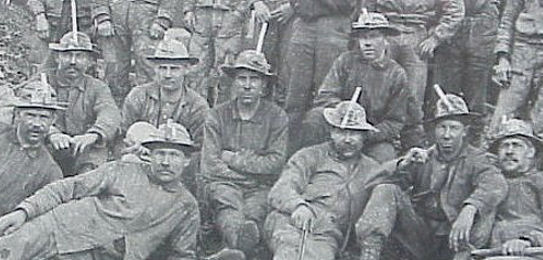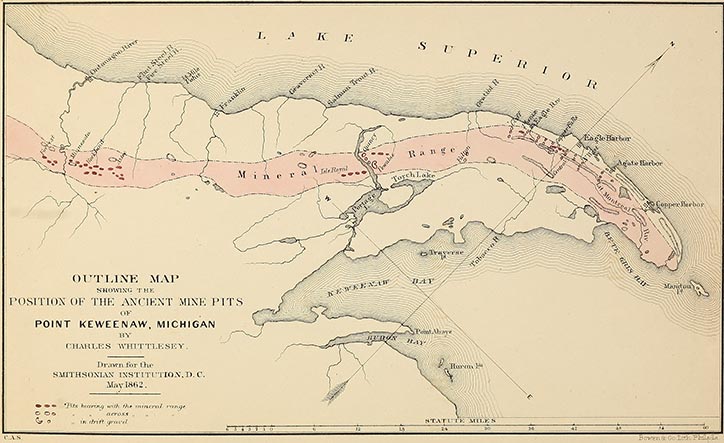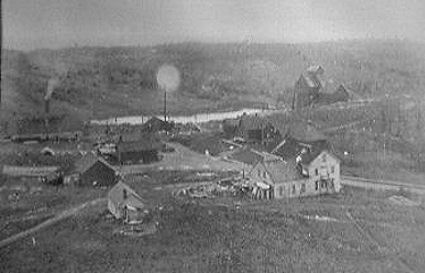Andrew A. Hall > Ada Clemina Hall > Horace C. Crofford > Virginia M. Crofford > Teresa Zaun Austin
Andrew worked in the copper mine in Ontogogan on Lake Superior. According to Ada, he was present in the mine the day they broke into a chamber and found dead men and some "queer" tools. This may be a reference to the more than a hundred "ancient mines" or artificial caverns discovered in this area. He was also there when they pulled out the largest piece of solid copper (527 tons) ever taken from the ground (see Minestota Mine). Ontonagon is part of the Keweenawan peninsula where large deposits, "geological freaks," of copper were found.
 |
| Miners at Minesota Mine |
 |
| Ancient Mine Pits |
 |
| Minesota Mine - productive years,1855-1862 |
 |
| John Cleveland Robinson |
Robinson was soon sent to Detroit as an army recruiting officer, and for a short time, assisted Governor William Dennison in raising troops in Columbus, Ohio.[2] In September 1861, he was appointed as colonel of the 1st Michigan Volunteer Infantry, a regiment he helped recruit.[2][3] That autumn, he was also promoted to major of the 2nd U.S. Infantry in the regular army, concurrent with his assignment in the volunteer army.[1] Within a few months, he was commanding a brigade of volunteers at Newport News, Virginia in preparation for the Peninsula Campaign.
Serving under General McClellan, Andrew took part in the Seven Days march to Richmond, carrying a very heavy case of surgical instruments. However, he became ill and was hospitalized in New York for six months. He came home weighing only 85 pounds and was an inch shorter than before he left. He was too weak to work for a time.
In 1864, Andrew was repairing railroad cars in Marquette. Ada's dates conflict with the 1870 census. According to the 1870 census, he was living in Delton, near Detroit in the southern part of Michigan, and was working as a watchman at the "furnace." By Ada's account, they lived at the Jackson Furnace in 1867 in the northern part of Michigan, and moved from there to Brainard in 1869, then to Fargo, ND. Ada wrote that Andrew worked as a bridge builder. He built the first frame house in Fargo as well as several other buildings in Brainard.
From Fargo: History: "Law and order followed with the arrival of new settlers on the first train of the Northern Pacific to cross the Red River on June of 1872."Andrew became discouraged by the hard living in Michigan and was beaten by the plague of grasshoppers that destroyed their crops and their homes. In 1875, they heard that the government was going to build a fort near the Black Hills. Settlers were given permission to accompany the army to the Black Hills, so the Halls moved to Fort Lincoln for a time. During this time, Ada taught school at Fort Lincoln and was present when Custer's men left for the Battle of Little Bighorn in 1876. According to Ada, who was also a writer and historian, the settlers traveled by wagon train in a long, tightly guarded procession to the Black Hills. Families were cautioned to stay together to be assured of safety. One couple did not follow this advice and were found dead, scalped by Indians.
They moved around, living in Central City, SD, then Bear Butte Creek. He received his pension and an inheritance from his father around 1880, so he bought cattle and horses. By 1886, they had settled on a ranch near Buffalo Gap by the Cheyenne River. They lived on this ranch for many years. Young men would come visit and see the girls on the Hall ranch. "Old Man Hall" was the subject of a little ditty they would sing for him. In 1890, there was the threat of an Indian uprising because of the "Messiah Craze"*, so men gathered at the Hall ranch for mutual protection. Horace Crofford was among these men. Horace and Ada were married the next year.
 Andrew and Olivia Hall later moved to Newcastle, Wyoming. In the days before his death, he deeded his land to Ada (copy of deed can be seen in Ancestry.com). Andrew is buried in Greenwood Cemetery in Newcastle.
Andrew and Olivia Hall later moved to Newcastle, Wyoming. In the days before his death, he deeded his land to Ada (copy of deed can be seen in Ancestry.com). Andrew is buried in Greenwood Cemetery in Newcastle.*The U. S. government had seized Lakota lands. Bison were hunted to near extinction. Treaties with the Indians were not implemented. An Indian prophet had a vision of Jesus returning as a Native American and restoring their lands. The Indians began performing the Ghost Dance, in which they believed they would be protected from the white man's bullets, and that the ghosts of the ancestors would return to earth. This was referred to by the white people as the "Messiah Craze." The white men feared this Ghost Dance and believed an uprising was imminent. An unfortunate series of events led to the Wounded Knee Massacre in South Dakota in 1890.
No comments:
Post a Comment
I welcome your helpful comments and feedback!